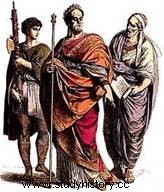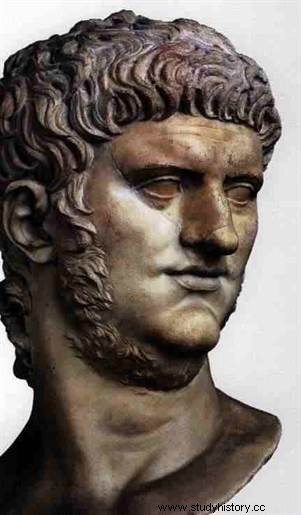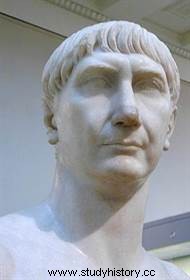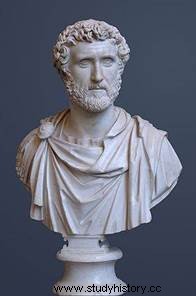 The term "emperor comes from the Latin word imperator, an honorary title given to victorious generals during the Roman Republic. The first Roman emperor was Octavian, the nephew and adopted son of Julius Caesar. In 27 BC, he received the title of Augustus, which means the divine, and that of princeps (that is to say the first of the citizens). From then on, he concentrated all the powers:he was the head of the armies, the head of the Roman religion and he possessed the legislative, executive and judicial powers. He receives many honors and a cult is rendered to him. The emperor himself chooses his successor by adopting him as a son. Until 476 (date of the fall of Rome), 87 emperors succeeded one another at the head of the Roman Empire.
The term "emperor comes from the Latin word imperator, an honorary title given to victorious generals during the Roman Republic. The first Roman emperor was Octavian, the nephew and adopted son of Julius Caesar. In 27 BC, he received the title of Augustus, which means the divine, and that of princeps (that is to say the first of the citizens). From then on, he concentrated all the powers:he was the head of the armies, the head of the Roman religion and he possessed the legislative, executive and judicial powers. He receives many honors and a cult is rendered to him. The emperor himself chooses his successor by adopting him as a son. Until 476 (date of the fall of Rome), 87 emperors succeeded one another at the head of the Roman Empire.
The imperatores of the Roman Republic
If there is a concept of power that fascinates as much as it terrifies, it is that of Roman Emperor . Indeed, the sovereigns of Rome, “the Divine Caesars”, to use the expression of Lucien Jerphagnon, are political leaders whose immensity of prerogatives represents one of the most absolute notions of government. And yet, paradoxically, the Romans had acquired a visceral hatred for tyrannical, personal power that had led them to reject kings and double the supreme magistracy, the consulship, in order to avoid one-man rule. It was only in the event of mortal danger for the State, that the republican system agreed to leave power to a single man, called dictator and for a limited period of six months. It is therefore interesting to find out what could have pushed them to accept such absolute power.
The Republic experienced many setbacks, mainly from the 2nd century BC, especially between patricians and plebeians. But it is on the side of the war and the generals that the deepest element of destabilization of the regime is to be sought. Indeed, since Scipio Africanus, the Republic, faced with the danger represented by Hannibal, had had to entrust the command of the troops to this young patrician, whose uncles had been killed in Spain. Despite his too young age, he was appointed consul and therefore left to fight the Carthaginian. The very fact of leaving authority, despite the laws, to a man who was too inexperienced created a precedent that was ultimately harmful. The armies, as the Roman state grew, remained longer and longer on a war footing, leaving citizens far from their homeland for long periods.
 The imperators , the Roman magistrates vested with the power of command in particular military, such as the praetors and especially the consuls (as well as pro-praetor and pro-consuls; magistrates sent to administer the conquered provinces, having already exercised the corresponding office), had then moreover in addition to freedom vis-à-vis the distant Senate, and at the same time had to settle the terms of the conflicts on the ground. In this sense, this inflation of their prerogatives made them conceive of their troops no longer as a civic army, called upon to be demobilized, but as their personal instrument, within the framework of their conquests. Despite everything, and even if they balked more and more, they had to free the citizens at one time or another, which deprived them of good experienced soldiers.
The imperators , the Roman magistrates vested with the power of command in particular military, such as the praetors and especially the consuls (as well as pro-praetor and pro-consuls; magistrates sent to administer the conquered provinces, having already exercised the corresponding office), had then moreover in addition to freedom vis-à-vis the distant Senate, and at the same time had to settle the terms of the conflicts on the ground. In this sense, this inflation of their prerogatives made them conceive of their troops no longer as a civic army, called upon to be demobilized, but as their personal instrument, within the framework of their conquests. Despite everything, and even if they balked more and more, they had to free the citizens at one time or another, which deprived them of good experienced soldiers.
Marius and Caesar
The solution was partly put forward by Marius, who proposed as a reform to allow poor citizens, sometimes called proletarians, to participate in war. Faced with the prospect of pay and booty, they willingly enlisted and hardly asked for demobilization. In this order of idea, the armies became quite won over to their commanders who could therefore fully play their immense power. The first to use it was also Marius, until his authority was challenged by one of his former students, Sylla. This is the starting point of a whole series of civil wars between imperatores , wishing to gain power. We quickly pass over the event details which are hardly our subject here.
We thus come to Julius Caesar, who after his conquest of Gaul, had under his authority a large and very seasoned army, with Gallic and German auxiliaries. From the crossing of the Rubicon, the war is launched against Pompey which ends with the victory of the first at Pharsalus. Back in Rome Caesar enjoys an uncontested and indisputable power; he is the big winner, no longer has an army worthy of the name against him. His power is often associated with that of a Roman emperor, and yet there are very clear differences in nature. Indeed, Caesar was appointed dictator for life by the Senate, which is therefore included in the republican institutions, but by agreeing to an incredible departure from the very principle of the regime. The time when Scipio the African, blessed with his victory over Hannibal, was driven into exile is long gone.
The March to the Roman Empire
Personal power in Rome, however, is not directly due to Caesar. It is once again the result of a civil war, this time against the last Pompeians, then between Octave and Marc Antoine. Power, once conquered by the first after crushing his rival at Actium, takes on a very particular hue. Indeed, by a great game of dupe, Octave proposes to the Senate to restore all his power to him and to withdraw from public life. Thereupon the Senate refuses and replaces Augustus in a favorable position; he agrees to become princeps (the first [of citizens]). But after many very complex reversals and very subtle maneuvers, going beyond the format of this short presentation (see on this question the collective work, Hervé Inglebert (Dir.) Rome and the integration of the Empire, volume 1), Octave , who was given the name of Augustus in 27 BC, remains in fact the master of power in Rome.
 He indeed possesses the supreme proconsular imperium (the power to command of both civilian and military type) , giving him authority over all the provincial governors (and from 23 BC he had authority over the senatorial provinces, that is to say left in law to the Senate; provinces pacified and practically without troops and over all the Italy, even Rome). Therefore he is also a superior judge.
He indeed possesses the supreme proconsular imperium (the power to command of both civilian and military type) , giving him authority over all the provincial governors (and from 23 BC he had authority over the senatorial provinces, that is to say left in law to the Senate; provinces pacified and practically without troops and over all the Italy, even Rome). Therefore he is also a superior judge.
His power cannot be disputed since he also inherits the famous tribunician power, a magistracy originally created within the framework of the struggle between patricians and plebeians, in order to to leave to the second a possibility of defending their interests (it is a magistracy occupied in particular by the Gracches), but which is, for Augustus, released from any constraint; unlimited in time and not shared. Thus he has inviolability making him sacrosanct, the right of veto over any decision of the Senate or of the magistrates, right of arrest, right to convene and preside over the Senate, right to propose oral or written measures before the Senate. , right to convene and preside over people's comitia, right to submit bills to comitia.
In addition, he is supreme pontiff and therefore spiritual leader of all the religions of the Empire, which gives him moral authority. He is also Prince of the Senate, which allows him to run for former magistracies, such as censorship (prestigious office accessible to former consuls and used to identify citizens exercising moral authority) exercised by Claude. The emperor of course has the right of war and peace, the right to present candidates to the magistracies who must be elected, the right to confer the city, to found colonies and to coin money.
This very long list of powers, a bit plethoric in appearance, in fact creates a veritable legislative wall which places the new strong man at the head of the State and against which he is very difficult to oppose. And of course, all this takes place without questioning the Roman Republic whose existence is still proclaimed in the middle of the 4th century AD. J.-C..
The Roman Emperor, a monarchical power?
 The Augustus, the emperor therefore, because the terms become synonymous, is therefore untouchable and can act at his will way. Thus the eccentricities of Caligula and Nero remain totally free from control. Moreover, the senators, seeking honors are extremely sycophants, doing their utmost to curry favor with the master of the Roman world. Multiple honors are thus granted to the emperors, maintaining the autocratic image of power. For writers, this period is the end of the Libertas (freedom as a concept, meaning much stronger than the French word), especially since the Julio-Claudians do not leave an imperishable memory; Tiberius was hated, Caligula and Nero condemned and Claudius often mocked.
The Augustus, the emperor therefore, because the terms become synonymous, is therefore untouchable and can act at his will way. Thus the eccentricities of Caligula and Nero remain totally free from control. Moreover, the senators, seeking honors are extremely sycophants, doing their utmost to curry favor with the master of the Roman world. Multiple honors are thus granted to the emperors, maintaining the autocratic image of power. For writers, this period is the end of the Libertas (freedom as a concept, meaning much stronger than the French word), especially since the Julio-Claudians do not leave an imperishable memory; Tiberius was hated, Caligula and Nero condemned and Claudius often mocked.
The government, presented as enlightened by the Antonines marks a fairly clear break, but above all corresponds to the reigns of emperors close to the Senate (like Nerva who comes directly from its ranks), which largely explains this favorable analysis. In any case, it must be kept in mind that in Rome, even after the effective end of the Republic, the management of affairs remains above all the fact of a plural organization between a princeps (the Emperor), the Senate, and the various magistracies of the Cursus Honnorum (literally runs through honors; it is in fact the various magistracies that the nobles had to accomplish up to the head of state; the consulate and the honorary magistracy of censorship), which makes the political leader, even while powerful, was still compelled to display a temperate appearance and therefore the least royal as possible.
Some of the criticisms advanced against the "bad" emperors are due to their overly monarchical exercise of their power, such as Nero's desire to have his gigantic " Maison Dorée”, even if it meant expropriating owners. It should also be borne in mind that in the early days of the Empire, the emperor was to be greeted as a provincial governor, and was not to display excessively ostentatious luxury through costume. However, looking more closely at the different reigns, the relationship of the emperors with the nobility remains a fundamental element. The harshest indictments against the princes have always been the fruit of execrable relations at the highest level of the State.
Tibère, who, in addition to alleged sexual escapades on the island of Capri, is unanimously denounced in the texts without however having shown as much eccentricity as Caligula for example. The cause is simple; bad relations with the aristocracy and in particular the Senate. So the question of the transmitted image of a reign is the result of clear-cut ideological positions, which on the other hand carry no negative criticism against the actions of the emperors deemed to be good. Trajan showed a permanent concern for his glory, which he included in Roman town planning with all possible gigantism. Its forum is the largest ever built, more than 170 meters wide with an equestrian statue of the emperor in its center. It is crossed by a huge basilica whose length is equal to that of the forum.
 The set ends with Trajan's Column, a monument representing on spiral reliefs the victorious campaigns of the emperor over the Dacians. At the top was a statue of Trajan whose head was at such a height that it tickled the feet of Jupiter Capitolinus according to a very explicit symbol. At the same time, and thanks to the booty acquired during the campaigns, the emperor had the largest thermal baths built at the time. But Trajan favored the Senate and hardly bothered the aristocracy during his campaigns which led him very far from Rome, so he was the optimus princeps , the best of princes.
The set ends with Trajan's Column, a monument representing on spiral reliefs the victorious campaigns of the emperor over the Dacians. At the top was a statue of Trajan whose head was at such a height that it tickled the feet of Jupiter Capitolinus according to a very explicit symbol. At the same time, and thanks to the booty acquired during the campaigns, the emperor had the largest thermal baths built at the time. But Trajan favored the Senate and hardly bothered the aristocracy during his campaigns which led him very far from Rome, so he was the optimus princeps , the best of princes.
The exercise of absolute power could therefore, with some adjustments, not trigger any criticism. At the same time the openly provocative behaviors of Caligula and Nero, although they resulted in the assassination of the emperors, brought no attempt at temperance, no open criticism, no real resistance. From this observation, the only real risk of the office was to attract too much enmity, or to remain too close to court intrigues.
From the Principality to the Dominate
This complex historiographical question now appears somewhat obsolete in recent works. The very substance of this thesis started from the principle of an original imperial regime tempered, degenerating towards an increasingly absolute monarchy. But he intends above all to imagine the insane powers in the hands of the first emperors, who, for those who used them in moderation, did not surrender their authority. For the others there was only physical elimination to overcome and no legal recourse could worry them. It is therefore a non-debate to oppose a regime that only asserted itself in a more direct way, the more the memory of republican freedom faded.
This Dominate was traditionally started under Septimius Severus, a military emperor disliked by the Senate, and whose certain authoritarian actions left some bitterness and in particular the execution of senators who took sides for his rival in the conquest of power. Nevertheless, the crisis of the third century, which brought to supreme power a number of military emperors, brought proof of a rigorous permanence in the exercise of power, the only limitation of which then dyed in the swords of the soldiers. The only difference being the sponsors of the assassinations; with the proliferation of troubles, the emperor, supreme military leader had to appear at the head of his troops, and the army took charge of the intrigues for power.
 Like Agrippina once, the great generals took it upon themselves to bring down the emperors who were too embarrassing. The frantic waltz of assassinations and usurpations rather marks a certain weakening of the power of the monarchs. The Roman State found a form of culmination in the exercise of the imperial office with the reign of Diocletian (284-305) who established oriental etiquette at court, the nobles having to prostrate themselves before the sovereign, kiss the bottom of her purple cloak, covered with jewels.
Like Agrippina once, the great generals took it upon themselves to bring down the emperors who were too embarrassing. The frantic waltz of assassinations and usurpations rather marks a certain weakening of the power of the monarchs. The Roman State found a form of culmination in the exercise of the imperial office with the reign of Diocletian (284-305) who established oriental etiquette at court, the nobles having to prostrate themselves before the sovereign, kiss the bottom of her purple cloak, covered with jewels.
The wearing of the diadem, which Caesar had constantly symbolically refused to show that he did not claim to be royalty, became the rule. We measure here a certain distance with the first emperors, but it is the habit of this absolute power which made that the Romans did not take umbrage of this evolution. The principality actually ceased to display a hypocritical republican facade, which Octave-Auguste had patiently constructed, to gain acceptance of his authority, to find a sort of adequacy between the real powers of the prince and their translation into etiquette. Diocletian proceeded in this way partly to establish the power of the emperors, undermined by the multiple murders of princes, and to create a distance between the imperial dignity and the common man.
The 4th Roman century, much more stable than the previous one, saw in any case a succession of emperors very often of military origin (or who came there like Julian) who the moderation of their morals, closer to Vespasian than to Caligula, was not noted, contrary to certain images of Épinal peddled until today. The ultimate evolution of the imperial power is due to its collusion with the Christian religion. From the beginning, the emperor was supreme pontiff and therefore head of all the religions of the Empire. But with the development of Eastern religions in the Empire, especially from the 3rd century, the image of the emperor became associated with the solar deity. This somewhat prepared the relationship with Christianity.
With Constantine I, this religion took on fundamental importance and the emperor claimed to be its leader, as evidenced by the meeting of the Council of Nicaea under imperial decision. But the princes never really measured the universalist claims of Christianity, which gradually exceeded those of the Empire. Despite everything, as long as the emperors kept all their authority, nothing really came to disturb their power, except assassinations.
Chronology and list of Roman emperors
Roman emperors fascinate:murders, usurpations and scandals seem to be intrinsically linked to their reigns. However, the Empire was relatively stable during the first two centuries of its history. This is all the more surprising since the inheritance rule has never been fixed! However, most of them were adopted during the lifetime of their predecessor. It is this chronology that is presented here. We will only mention a few explanatory elements to help the reader understand certain successions.
The Julio-Claudians (27 BC-68)
- Augustus (27 BCE-14)
- Tiberius (14-37)
- Caligula (37-41)
- Claudius (41-54)
- Nero (54-68)
Nero's suicide drags the empire into instability.
The Year of the Four Emperors (68-69)
- Galba (68-69)
- Othon (69)
- Vitellius (69)
The fourth emperor who finally wins, founds the Flavian dynasty
The Flavians (69-96)
- Vespasian (69-79)
- Titus (79-81)
- Domitian (81-96)
The assassination of Domitian allows the rapid accession, with the complicity of the Senate and without great difficulty, of Nerva to the head of the empire.
The Antonines(96-192)
- Nerva (96-98)
- Trajan (98-117)
- Hadrian (117-138)
- Antoninus the Pious (138-161)
- Marc Aurelius (161-180)
From Marcus Aurelius, emperors regularly appoint their son to reign with them and prepare the succession.
- Chest of drawers (177-192)
The Second Year of the Four Emperors (193)
- Pertinax (193)
- Didius Julianus (193)
- Pescennius Niger (193-194)
- Clodius Albinus (193-197)
Septimius Severus gains the upper hand over his competitors and founds his dynasty.
The Severans (193-235)
- Septimius Severus (193 – 211)
- Caracalla (198 – 217)
- Geta (209 – 211) reigns with his brother before being assassinated by the latterJ
- Macrinus (217 – 218) is not from the Severan dynasty. He seizes power after ordering the murder of Caracalla.
- Diadumenian (218), son of the preceding and named by this last co-emperor before being executed with his father.
- Elagabalus (218 – 222) return of the Severans to power.
- Severus Alexander (222 -235)
The assassination of Severus Alexander ended a period of relative stability and dragged the empire into a period of crises, unrest and political anarchy.
3rd century anarchy (235-285)
- Maximin the Trace (235-238)
- Gordian I, Gordian II, Pupian, Balbinus (238)
- Gordian III (238-244)
- Philip the Arab (244-249)
- Decius (248-251)
- Trebonianus Gallus (251-253)
- Hostilianus (251)
- Volusian (251-253)
- Emilian (253)
- Valerian (253-260)
- Gallian (253-268)
- Claudius II the Gothic (268-270)
- Quintillus (270)
- Aurelian (270-275)
- Tacitus (275-276)
- Florien ( 276)
- Probus (276-282)
- Carus (282-283)
- Numerian (283-284)
- Carinus (283-285)
From Diocletian, the imperial power is shared between several "Augustes" and their seconds, the "Caesars" to organize the defense against the first barbarian invasions.
Dominate of the Constantinians (235-285)
- Diocletian (284-305) and Maximian (286-310)
- Galley (306-310), Constantius Chlorus (305-306), Severus II (306-307), and Maximiem II (307-313)
- Constantine I the Great (307-337)
- Constantine II (337-340)
- Constant (337-350)
- Constance II (337-361)
- Julian the Apostate (361-364)
- Jovian (363-364)
In 364, the Roman Empire was definitively divided between West and East. While the Western Roman Empire gradually succumbed to barbarian invasions until it became a fiction after Valentinian III, the East, later known as the Byzantine Empire, would survive until 1453.
Emperors of the West - Emperors of the East (364-476)
- Valentinian (364-375) - Valens (364-378)
- Valentinian II (375-392) - Theodosius (379-395)
- Honorius (395-423) - Arcadius (395-408)
- Valentinian III (423-455) - Theodosius II (408-450)
- Petronius and Avitus (455-456) - Marcian (450-457)
- Majorian (456-461) - Leon (457-474)
- Livius Severus (461-465)
- Anthemios (467-472)
- Olybrius (472)
- Glycerius (473-474)
- Julius Nepos (474-475) - Leo II (474)
- Romulus Augustulus (475-476) - Zeno (474-491)
Bibliography
- The Roman Emperors, by Pierre Cosme. PUF, 2016.
- R. MARTIN, The twelve Caesars:From myth to reality, Tempus, 2007.
- The Roman Emperors:27 BC. JC- 476 AD. JC, by François Zosso and Christian Zingg. Wandering, 2009.
